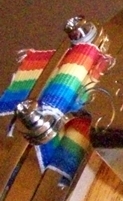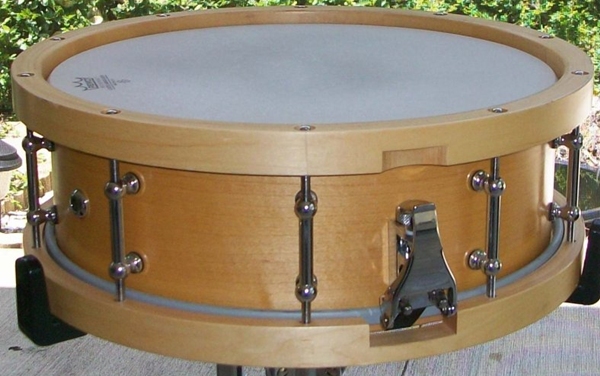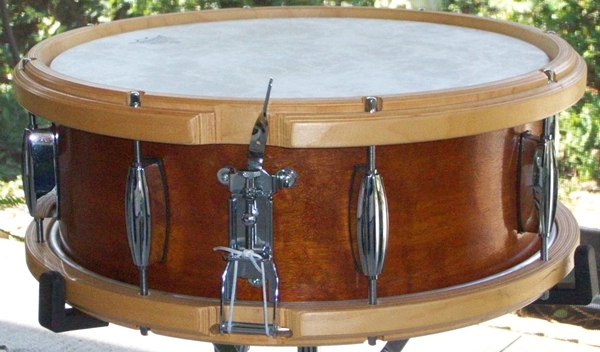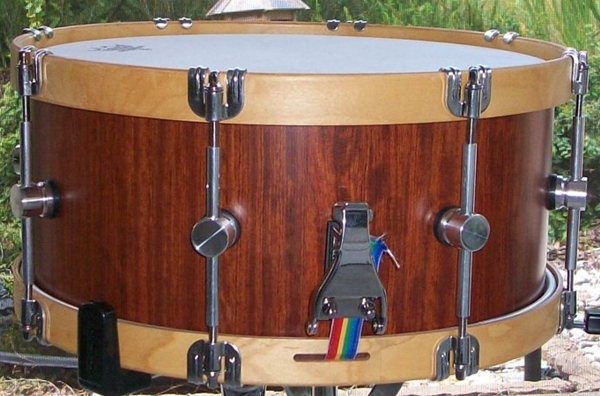A recurring lament expressed by new owners of the Gretsch Catalina Club Jazz kits, as well as other low end, competing kits such as the Tama Stagestar, is the bass drum and toms sound fantastic, but the snare drum doesn't.
There is a reason why the snare drum in particular is the weak link: the shell is made of Philippine mahogany, also known as Luan. That is the one characteristic that the Gretsch Catalina Club Jazz kit shares with its cousins, including the Japanese stencil kits of yesteryear.
Philippine mahogany is a fairly soft wood compared to higher-end shell material, and it absorbs more of the energy when you strike the batter head than maple or other premium shell woods. This diffuses the sound and affects the shell's resonance. One of the reasons that this has less effect on bass drums and toms is the snare drum is shallow relative to the other drums and is more sensitive to the wood characteristics.
Another reason, again related to shell depth, is these drums are mass produced and there are tolerance variations, especially in critical areas such as bearing edges. Where the shallow depth comes in is that the drum will be more sensitive to small variations and imperfections in the edges than a deeper drum.
To be fair to Gretsch and other companies making these drums, when you are cranking out thousands of kits for the low end market, doing a final polish on the bearing edges is an extra step that adds cost. A good enough bearing edge is sufficient from a manufacturing perspective. And to be fair, the edges are good enough for a low end kit. Unless, of course, if you happen to want to wring out better tone and response from the snare drum.
Here are a few tips to transform that weak link in the kit into a snare drum that is more than adequate. I'll provide the tips from least to most expensive. Also note that I am focusing on the snare drum, but the tips can apply to all of the drums in the kit. In addition, these tips will work with vintage Japanese kits, such as Whitehall, Star and a plethora of other stencil drum kits that flooded the market in the 1960s.
Dressing Bearing Edges
The single most effective thing you can do [in my experience] is to dress the bearing edges. Tools and materials are 320 grit sandpaper and a dressing compound.
320 grit sandpaper is sufficiently fine to polish the edges while removing any tiny rough spots. The dressing compound I prefer is a Carnauba wax bar. They are inexpensive and one bar will last a long time. However, there are other valid dressing compounds. Two master drum builders, both of whom I hold in the highest regard, have differing approaches that you may want to consider. J.R. Frondelli simply wipes on a coat of varnish, while Kevin Smee of Bowie Custom Drum uses a paste wax such as Briwax or Johnson's fine finishing wax. Another product that will work well if you want to go this route is Minwax Paste Finishing wax. Regardless or your choice - and you do have choices - the dressings will seal any air gaps in the bearing edge and provide a smooth surface for seating your drum heads.
Step 1 is to lightly go over the bearing edges with the 320 grit sandpaper. The operative word here is lightly. You want to remove any minute high spots and polish the edges, not do any major surgery. I fold the paper over the edge, taking care to not touch the outside finish or wrap, and lightly follow the circumference of the shell. Be sure to follow the contour of the snare beds too. You should feel a very slight resistance when you begin. In fact, you can hear a slight scratchy noise. As you proceed and make an entire pass the resistance will diminish, as will the scratchy sound. Once the resistance and scratchy sound are gone, you are ready for the next step - wiping the dust off the edges. A clean cloth with a touch of denatured alcohol works well.
The final step is to dress the edges. If you opt for a varnish dressing per J.R. Frondelli's approach, use a clean cloth and wipe on a very small amount on the edges and let dry. If you opt for the wax (be it the Carnauba wax bar or paste wax), lightly apply the wax and buff it out. For this step I use Meguiar's X2020 Supreme Shine Microfiber. Reassemble the drum, tune it up and I believe you will be treated to a discernible difference in sound.
Coating the Shell Interior
This approach, along with dressing the bearing edges, will give you the most bang for your buck, but is more time consuming than dressing the bearing edges. I have found that coating the shell interior is the key to dramatic improvement in the sound of the snare drum that ships with the Catalina Club Jazz kit (as well as the other drums I mentioned above.) It does give the snare drum a more focused sound, and makes it a bit more sensitive as well. Note: If you elect to perform this step, do it before dressing the bearing edges.
What you will need:
Here are the steps:
- Remove all hardware from the snare drum (lugs, throwofd and butt)
- Using the 3M 2090 Scotch-Blue Painter's Masking Tape, mask off of the holes on the exterior side of the shell, and the bearing edges.
- Apply the shellac to the interior of the shell. Do not flood the wood with shellac. I lightly dip the muslin into the shellac that has been shaken per manufacturer instructions, then apply it in a circular motion until I have the interior completely coated. One coat will work, but I usually let the shellac dry for a day, and repeat the process until I have three coats.
- While you are waiting for the shellac to dry take the time to lightly spray WD-40 on the moving parts in the strainer, as well as the tension rod threads. Don't over do it - a little WD-40 goes a long way, and you do not want to reassemble the snare drum with dripping parts.
- After the shellac has dried, remove the tape, reattach the lugs, throwoff and butt, and perform the bearing edge dressing step.
Other Tweaks
One of the modifications I make to any snare drum that comes equipped with plastic snare wire straps is to replace them with grosgrain ribbon. In most cases the simple (and inexpensive) replacement of the plastic snare wire straps with grosgrain ribbon will result in an immediately noticeable improvement in snare response.
Most plastic snare straps are 3/8" wide, but I typically buy 5/8" wide grosgrain ribbon because it perfectly fits the Catalina Club (and every other) snare drum throwoff and butt. The thinner, 3/8" ribbon can cock when threading it through the strainer and butt clamps, skewing your wires. You can purchase this item, in a variety of colors, from Walmart and any fabric store. Here is a photo of one of my snare drums outfitted with it:

I also replace stock snare wires with premium wires such as the German steel wires. These wires are, in my opinion, the equal of Puresound custom wires, but at a fraction of the price.
Obviously, swapping out the stock heads on the Catalina Club Jazz snare drum is an option that may improve the sound. That said, the heads that come stock with it are relatively decent. I personally prefer different heads, and you probably have your own preferences. However, before rushing out and spending even more money, give the stock heads a try after you have tweaked the snare drum per my tips.
If you do want to explore different heads, you may want to examine some of the recommendations that I made in this post, as well as this follow-on post. You may also find some of the information in my approach to tuning useful.
Now turn that dog into a snare drum you would be pleased to gig with - and good luck.





